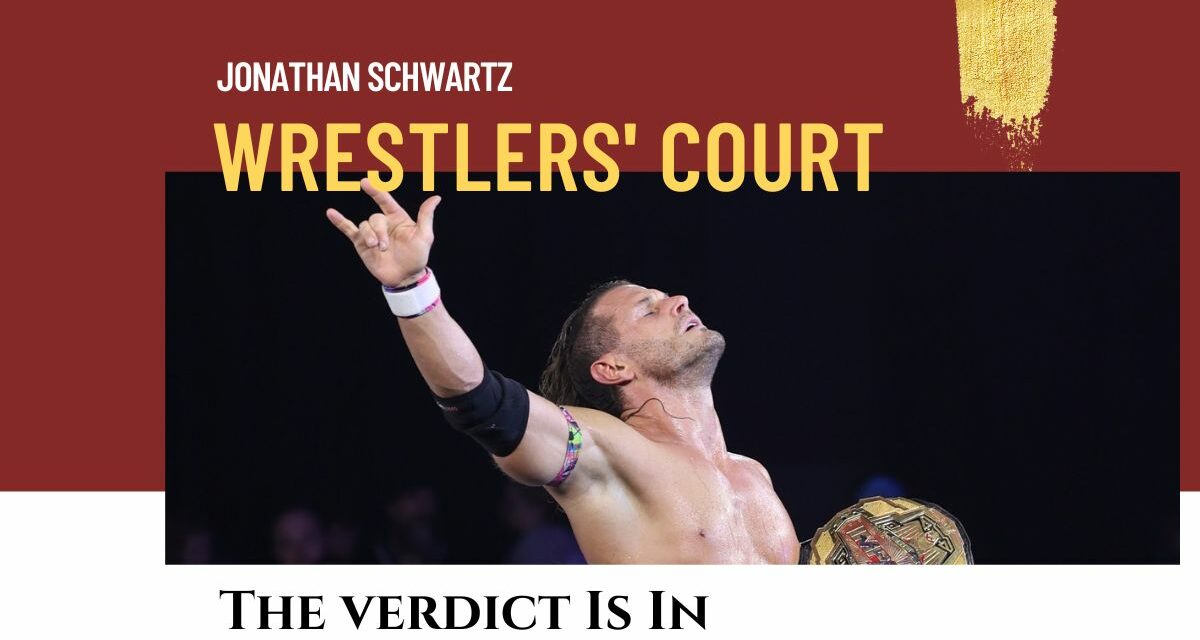Recently, I wrote about wrote about Adam ‘Edge’ Copeland, and the distinct possibility that his recent Smackdown match may have been his last. It seemed like the whole purpose of his 2020 WWE comeback was to right what he saw as an historic wrong and retire on his own terms rather than being forced out of pro wrestling by injury.
By now, we all know this was not his last match. As soon as his WWE contract ended Mr. Copeland showed up in the main event segment of AEW’s WrestleDream pay-per-view, and again on the October 4 edition of Dynamite. Copeland has started his AEW tenure with a version of the “grateful to be back” promo that has followed him since his return from a serious injury 11 years ago and has already named several opponents he wants to face.
But first, Copeland will revisit his off and on feud with his lifelong best friend, ‘Uncle’ Jay Reso, whose current run as Christian Cage — AEW’s evil resident stepdad is one of the funniest things on television. Between Copeland’s daughters referring to Christian as ‘Uncle’ and the daddy issues that flank his character, I really hope we’re in for some very loud ‘Uncle Daddy’ chants in arenas across the US.
Copeland’s move has attracted mixed reviews from fans. He’s been open with the media about his decision not to actually retire and brought his family’s views into the equation. He’s spoken at length about wanting to close out his career in AEW and have fun. He says he and WWE have broken up amicably, and that Copeland’s decision to continue his career stems largely from the fact that he wanted to do more, but felt hemmed in by a contract that offered limited dates. Ultimately, both sides struggled to find meaningful programs for Copeland, so if he wanted to keep wrestling and contribute more meaningfully it was time for both parties to move on. That said, some fans on social media have been vocal about a perceived lack of loyalty to WWE (which is ridiculous, given that WWE just released a number of longstanding employees and performers), Copeland’s advanced age and the fact that while Copeland and AEW owner may want him on the show and wrestling much more frequently than he did in his second WWE run, at this stage Copeland’s health might say otherwise. Remember: Tony Khan brought CM Punk back under similar circumstances (more on him later).
While Copeland’s attitude backstage may be better, there’s something to be said for protecting one’s assets, especially when there are lots of young stars to fill up a card.
For all of WWE’s ‘retirement’ talk in advance of Copeland’s match with Sheamus, including the issuance of a commemorative title belt, it now seems this match has been retconned as a retirement of the character Edge. It seems that Edge may be the only part of Copeland’s wrestling persona that WWE actually owns. I was surprised to hear Copeland come out to his “Metalingus” theme music — but Khan has proven his willingness to invest in mainstream music when it comes to how his wrestlers present themselves… and WWE never bought the rights to the song. I was more intrigued to hear Copeland referred to as the ‘Rated R Superstar’ which a key part of his WWE branding. Turns out that WWE let that trademark lapse all the way back in 2020. That sort of thing rarely happens — WWE fought with Cody Runnells over the ‘Rhodes’ surname for years. The best recent example was another semi-retired ex-WWE superstar: Santino Marella, who was able to claim that expired trademark and now uses the name and the rest of his goofy character over in Impact Wrestling. But, much as I like his work, Santino isn’t a draw the way Tony Khan hopes Copeland will be.
Let’s backtrack a bit, shall we?
Before Copeland even wrestled his last contracted WWE match the rumor mill was churning out reports that he would debut with rival promotion AEW at any moment. These rumors picked up steam with the September 27 edition of Dynamite, wherein new world title challenger ‘Switchblade’ Jay White was attacked by a group of masked thugs — the leader of which may or may not be revealed as Copeland (even if it was, they couldn’t have used him on screen since his contract technically doesn’t end until September 30 — and so far, the mystery man has yet to be revealed).
Edge downplayed claims that he would wrestle elsewhere, noting that he had a standing offer to continue his work with WWE. The internet fired back claiming that both sides are far apart on compensation, making likely that Copeland would join a rival promotion rather than go gently into that good night of shuffleboard and Mah Jongg tournaments and Early Bird Dinner Specials.
As often happens when I venture down a topical pro wrestling rabbit hole, I start thinking a bit more broadly. Today, I consider two aspects of pro wrestling retirements: what happens when retirements don’t stick (or turn out to be, as above-captioned, false finishes to a wrestler’s career), and why does it feel like some wrestling retirements are less the retiree’s choice and more a statement by a business which has left them behind.
I’m a bit uncomfortable with the subject of retirement. I have plenty of friends at my ‘shoot’ job who are closer to it than I am, and their views on the subject vary. Some are counting down the days, while others are anxious about everything from affordability in the wake of inflation, to what they will do with their new-found free time. A few have tested the waters but come back part-time in consultant roles. I admit, I like that option.
The nature of work has changed in general. Historically, one could expect to retire at 65 years old from a steady job, draw down a combination of public and private pensions and benefits, plus invested savings and realistically live for another five or ten years before shuffling off one’s mortal coil. It seemed like a good system. Now, work is much less steady and benefits/pensions across most sectors of the economy are greatly reduced. We live longer and in better shape, meaning we have more time to fill and a broader productive horizon with which to fill it. And the prospect of outliving whatever resources we’ve amassed in our working years is very real. Add the fact that for many people work gives a sense of purpose and direction (even if we occasionally grumble about it) and becomes a source of long-standing valued relationships — plus a viable paycheck, and it feels tough to give up.
So I understand ambivalence about retirement. I feel it myself. And while I’ve still likely got more working years ahead of me than behind me, the subject never sits right. My desk job entails neither the risks nor the rewards of my heroes’ but I do semi-joke about having to be carried out of my workplace feet-first when the time comes. I might not go out doing what I love, but at least I’m unlikely to be bored.
Back to wrestling.
Outside of WWE there are many examples of wrestlers who have retired and come back, often more than once, to acclaim.
Current Impact Wrestling World champion Alex Shelley first retired in 2018, following an assortment of injuries and personal challenges. I was disappointed at that news when it came out. Having watched Shelley compete regularly for Mississauga indy fed UWA, I always thought he had ‘it’. Shelley had made a career on the independent scene and collected singles and tag team belts between pre-Khan Ring of Honor, TNA/Impact Wrestling and New Japan. Shelley was (and is) an all-around star; an excellent cocky/desperate heel or sympathetic underdog babyface; a technical wrestler or high-flyer. He’s been in the ring with just about everyone unaffiliated with WWE (though he has a cup of coffee in NXT too) and always puts on a compelling performance. Shelley has been part of two great tag teams: off and on with Chris Sabin as the Motor/Murder City Machine Guns, and with Kushida as the Time Splitters. For all of his accomplishments, Shelley never won a ‘major’ world championship… and that may well have been fine with him, even if his fans might have appreciated the shine that a title run brings to a pro wrestling career.
I’m happy to say that Shelley still has ‘it’. There may be some debate about whether his 2018 retirement was a work or shoot: in any case, he was working towards his degree in physical therapy and understands that however his in-ring career finally ends, he will have to find something else to do. Shelley is only 40 years old but his high impact style might make for an abridged second run. He was also a talent whom it seemed never won the full confidence of promoters. Across his multiple ROH and Impact stints Shelley saw contemporaries like Austin Aries (more on him later), Christopher Daniels, Jerry Lynn and tag team partner Chris Sabin hoist world championships, but he always seemed to be passed over.
Shelley’s current Impact run has been interesting. In March 2022, Shelley lost to his student, ‘Switchblade’ Jay White in a match that was meant to build up the latter. In July, Shelley would beat Sabin in a number one contender’s match. Shelley would unsuccessfully challenge then-Impact World Champion Josh Alexander in August — a great match which I didn’t really think Shelley would win… but a year later, on June 9, 2023 Shelley would defeat Steve Maclin for that title. He has since defended it against a visiting Nick Aldis, and is primed for a rematch against Alexander, who is returning from injury. I don’t know whether Shelley’s title reign will be long but I’m glad it’s in the books. If one is driven to come back, this seems like a good way to do it.
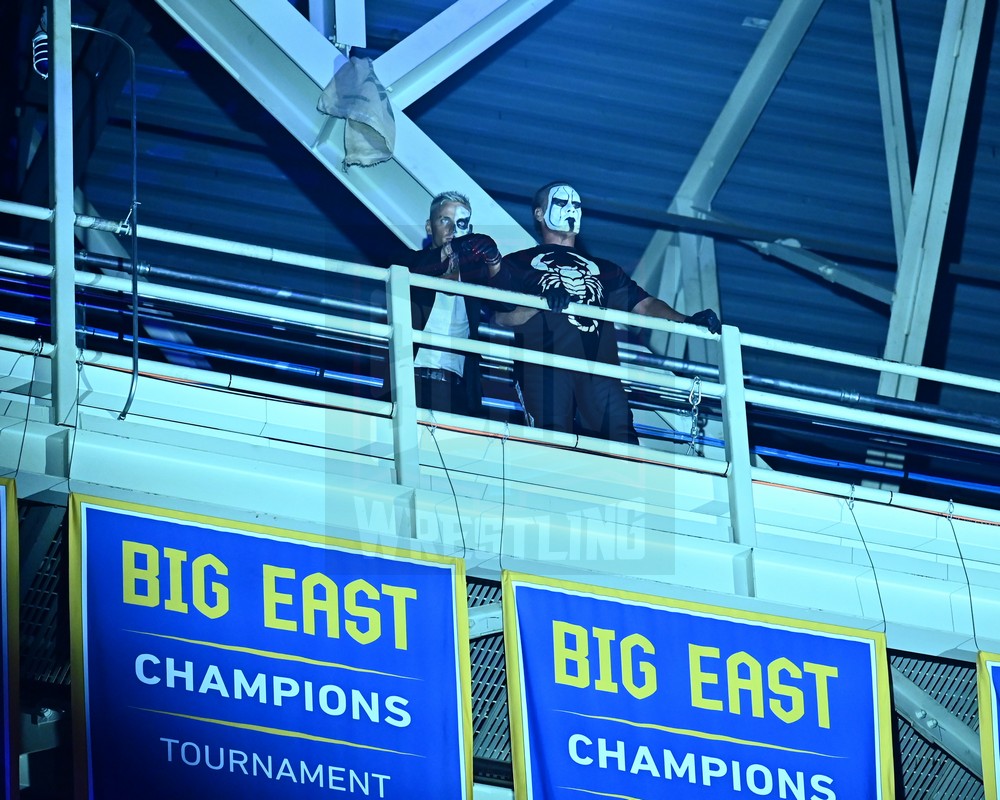
Darby Allin and Sting at AEW Rampage at the Petersen Events Center in Pittsburgh, on Friday, August 13, 2021. Photo by Joe Hrycych, www.hrycychphotography.com
Over in AEW, Sting was allegedly retired at the hands of Seth Rollins following a disappointing WWE run. At 62, he’s slowed down considerably, but in contrast to other older talent like CM Punk (who apparently lost his job after I started writing this, but I’ll get back to him) Sting has been booked smartly: he works almost exclusively tag team or six-man matches, hits a few low-impact versions of his signature moves, and has developed a fondness for jumping onto opponents laid gracefully on gimmicked tables. Fans keep speculating as to when Sting will permanently retire, but between the facepaint and dye job and layers of clothing to camouflage an aging physique, he’s found a niche among fans who appreciate his body of work — without announcers’ snide remarks diminishing his accomplishments. Even better, Sting’s current AEW run passes the torch from one high-risk, war-painted warrior to another. I’m not a huge Darby Allin fan but I appreciate AEW’s attempt at establishing continuity and long-term storytelling.
The Rock ‘n’ Roll Express (Ricky Morton & Robert Gibson) at the Icons of Wrestling Convention & Fanfest on Saturday, December 17, 2022, at the 2300 Arena, in Philadelphia, PA. Photo by George Tahinos, https://georgetahinos.smugmug.com
There are plenty of wrestlers who get into the ring well into their later years, relying on cheap pops and an abbreviated ‘greatest hits’ set of spots to service fans in small venues across the US (and I imagine elsewhere). ‘Handsome’ Jimmy Valiant is 81. He only retired last year, wrestling well past his last heydays in WCW and Memphis, on independent cards throughout the Southern US. Ricky Morton is 66 and has been active on the independent circuit since his last visible run with TNA in 2003. He’s also appeared as part of the Rock ’n’ Roll Express with partner Robert Gibson (who only just retired himself following hip replacement surgery) in New Japan Pro Wrestling, Impact and AEW in 2019. He has been featured in an increasingly managerial role with the revived NWA since 2020. But then he’s spent much of his career in tag teams, firing up the crowd and getting beaten up so he can make a hot tag. Morton has been open that he’s worked as long as he has due to spousal and child support obligations. While I’d hope his circumstances have since changed, at one point he was vocal that he can’t afford to retire.
At 61, George South is the spring chicken of this group. An uncontestably talented wrestler and natural heel, South worked mostly as enhancement talent in WCW and occasionally in the WWF. South was so proficient in this role that he would regularly suit up as one of a series of masked enhancement tag teams — going so far as to lose to perennial prunes the Mulkey Brothers. South would have greater in-ring success on the independent scene, particularly on shows that he promoted or co-promoted with fellow undercard legend Gary ‘The Italian Stallion’ Sabaugh. South’s greatest legacy may be as a trainer; he was involved in the development of the likes of Mark ‘Henry Godwinn’ Canterbury and Ron ‘R-Truth’ Killings and is credited with bringing Matt and Jeff Hardy to the WWF. South uses his matches as a platform for his religious beliefs. He can be a bit of a polarizing figure on social media (he once called me out directly for linking one of his posts to detractor Chris Cruise; I was as honored as if Antonio Inoki had slapped me).
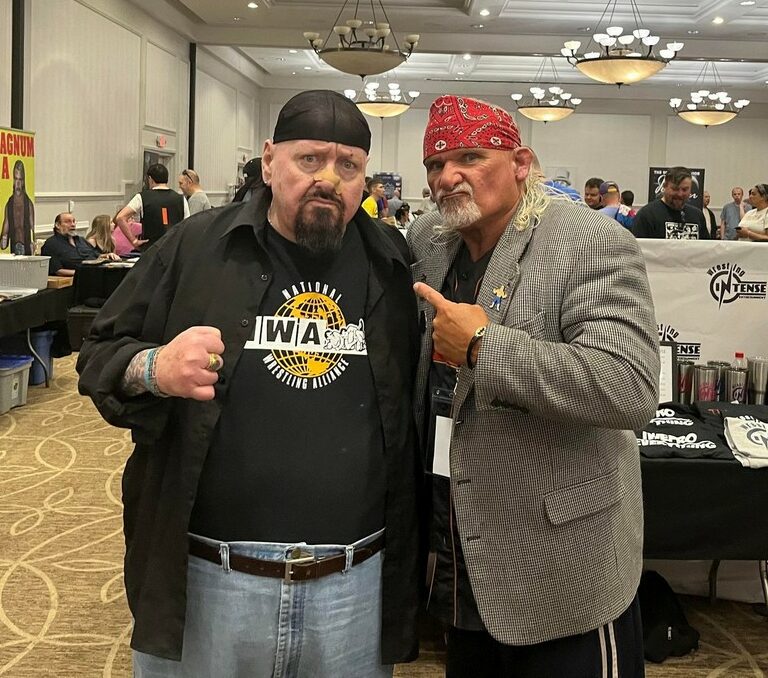
Rick Link and George South at The Gathering in Charlotte, NC, on Saturday, August 5, 2023. Photo by Greg “Count Grog” Mosorjak
Some, like Cruise, see South’s continued presence as an active competitor (like Valiant or Morton) as hurting what little credibility pro wrestling has left. Without offence to Messrs. Valiant, Morton or South (or others like Bob Orton, Tito Santana, Tony Atlas or Greg Valentine) I take his point. Abdullah the Butcher ‘wrestled’ until 2010. For at least a decade those matches consisted of Abdullah lumbering around ringside, blading opponents and being bladed himself without setting foot in the ring. He only stopped following a lawsuit by fellow wrestler Devon ‘Hannibal’ Nicholson, who alleged that he contracted Hepatitis C after working with Abdullah.
Ric Flair had one of the greatest all-time retirement matches against Shawn Michaels at WrestleMania XXIV in 2008, despite being limited to a routine of punches, chops, flops and the figure four leglock. He’s come back a few times since then: a tour of Australia with Hulk Hogan. A TNA run. His independent show in Tennessee last year, where he allegedly fell asleep in the corner and then passed out in the ring… he has said that he still craves one more match.
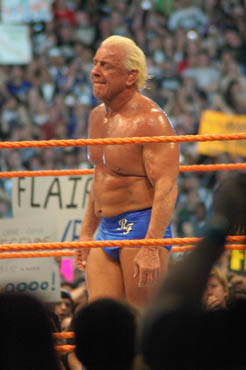
Ric Flair after losing his retirement match at WrestleMania XXIV. Photo by Mike Mastrandrea
Shawn Michaels was one of the few wrestlers to honor a retirement stipulation, going out on his shield against the Undertaker at WrestleMania XXVI. Until Edge (and more recently Stone Cold Steve Austin, who returned after a nearly 20 year layoff to main event WrestleMania against Kevin Owens last year in a non-match), Michaels himself had one of the best comeback stories — initially retiring in 1998 after a back injury and returning in 2002. Michaels’ second retirement would last from 2010 to 2018, when he would be coaxed out of retirement by a massive payday to team with Triple H versus the Brothers of Destruction in a dire match at Saudi Arabian special Crown Jewel.
Mick Foley infamously retired in 2000 after years of damage from hardcore wrestling began to have cognitive effects. He came back within six weeks to main event WrestleMania 2000 in a fatal four-way match. He would wrestle again in 2004, competing in that year’s Royal Rumble and in a losing effort when the Rock ’n’ Sock Connection fought Evolution at WrestleMania XX. My favorite of these late-career tilts took place against Edge in 2006 at WrestleMania 22 in a Hardcore match which disguised his obvious physical limitations. Foley would go on to other feuds, then to TNA himself as a less mobile World Champion in 2008-09. He would be positioned to feud with Dean Ambrose in NXT as recently as 2012, but doctors finally refused to clear him to compete and Foley would announce his permanent retirement.
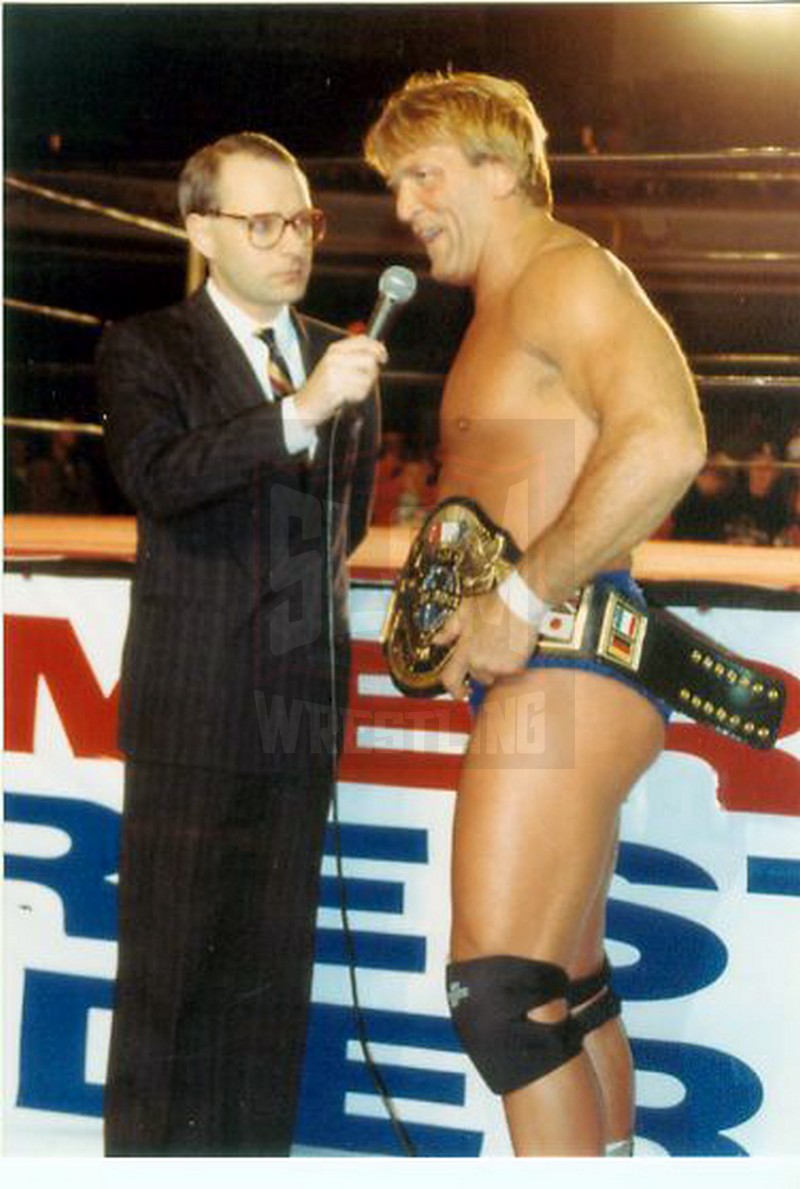
Chris Cruise interviews “Mr. Wonderful” Paul Orndorff. Photo by Mike Lano, WReaLano@aol.com
When I catch these performances on YouTube I’m inclined to agree with Cruise. Athletically and artistically, the human body is a finite instrument, and while I would not presume to tell anyone what to do, especially in the face of significant financial pressures or the promise of great reward, I have a measure of respect for those who exit close to the top of their game. It’s worth noting that Foley, Flair and Michaels have all expressed regret for some of their more recent comebacks, feeling that performing at less than their prime has taken some of the shine off their respective bodies of work. In the meantime, the recent Writer’s Guild of America strike had several semi-retired stars like John Cena, The Rock and Batista appear (or at least muse about appearing) for their own wrestling comebacks. Fans have speculated that this year’s WrestleMania could see Cena, The Rock and a prodigal CM Punk in key matches on the card.
Noted wrestling commentator Evan Ginzburg might balk at my view that at some point public figures should step out of the limelight, and that performance can too easily slip into self-parody. Entertainment also demands novelty, and younger generations of wrestlers deserve the chance to excel without having to conceal the limitations of older workers. One of the consistent criticisms of WWE programming (and most promotions) is the owners’ conservatism in pushing established acts, even as they age out of credibly playing world-beating heroes and villains. Ginzburg often speaks of ageism being the only acceptable prejudice. Having worked in the human rights sector, I hate to say that way too many forms of prejudice enjoy way too much popular acceptance.
For the sake of this argument, I agree that if these wrestlers, or any (including Edge) think that they can still command an audience’s attention then by all means they should go out and try to do so. But they need to be ready to anticipate the changing tastes of an audience with a limited appetite for nostalgia and ever-growing expectations for action.
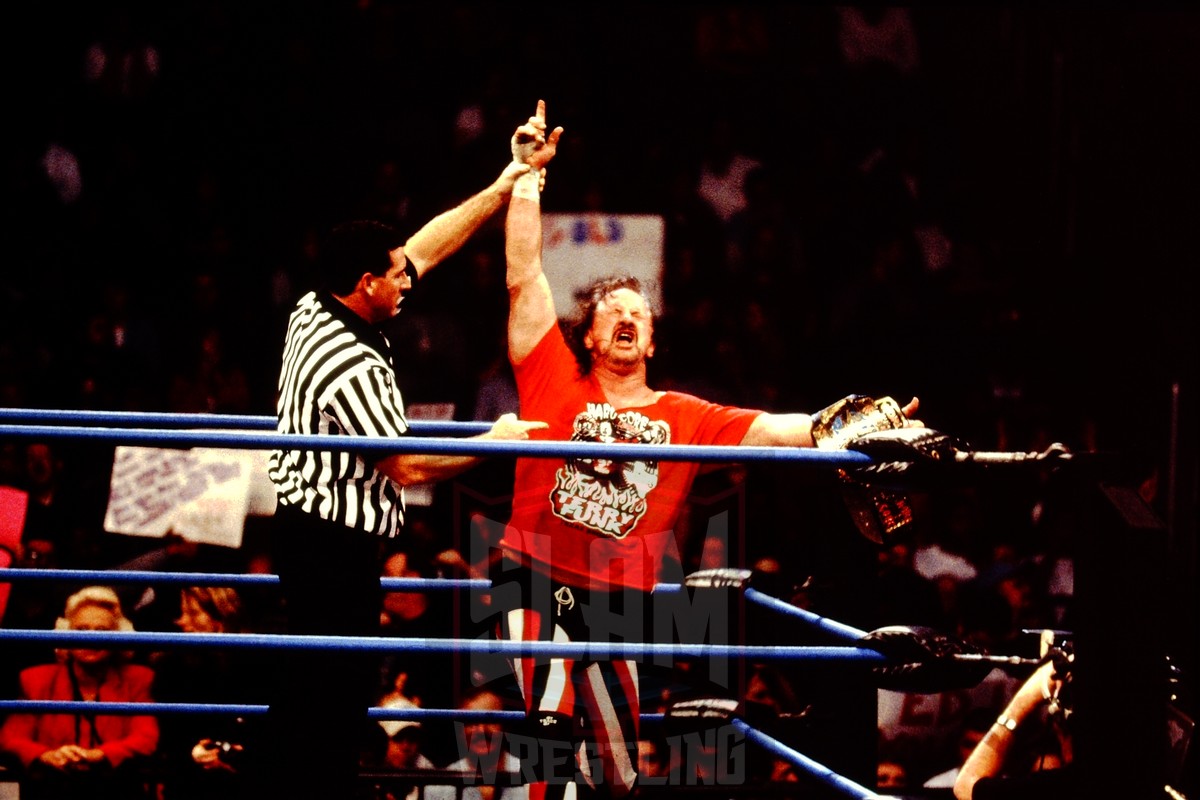
Terry Funk is victorious. Photo by George Tahinos, georgetahinos.smugmug.com
The late Terry Funk proved a master of reinvention in everything from his promos to his wrestling style. From scientific classics to brawling to death matches to modern ‘hardcore’, Funk could do it all, and sell all of it on the microphone. Funk turned a one-word promo “Forever!” into a touchstone for fans and in a business that privileges young, beautiful bodies, made ‘middle aged and crazy’ part of his act way back in 1989. His work is evergreen, and if it were possible to replicate without the damage in caused him, is worth studying by any aspiring wrestler. Roddy Piper also somehow lived outside the norms; even as his body slowed, what drew fans to his character was the sheer lunacy he brought to the party. Piper could also work against most opponents, a believable face or heel even though he was often the smaller man in the ring.
Some wrestlers’ retirements seem to reflect consensus between them and an industry which tires of their antics.
Charles ‘David Starr’ Barsky had an impressive career on the independent scene when he was accused of sexual abuse by a former girlfriend as part of the Speaking Out movement, which saw a host of (mostly) male wrestlers called out for misconduct. Barsky denied the allegations made against him. Promotions with which he was affiliated made clear their intentions to stop working with him and stripped him of any titles he held. Barsky would formally retire soon after, even as he continues to deny the allegations made against him.
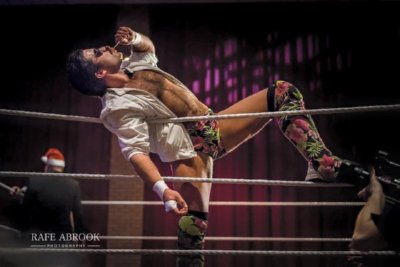
Joey Ryan in his prime.
Joseph ‘Joey Ryan’ Meehan had worked with all kinds of promotions including Lucha Underground and Impact Wrestling. He was part of a deliberately distasteful extended segment in the first pre-AEW ‘All In’ pay per view and his sleazy on-screen character seemed poised to break out at a time when the then-President of the United States glorified ‘locker room talk’. Turns out Meehan’s sleaze was not just part of his act. In June 2020, Meehan was accused by at least 17 women of sexual misconduct. He was released from his contract with Impact Wrestling and despite efforts to sue his accusers and kickstart his own comeback in March 2021 at an event called Wrestling 4 Women Charity, wrestling companies have made clear that he is unwelcome at their events. Meehan’s reputation has followed him into the world outside pro wrestling: he was reported to have worked at Disneyland for three months in 2022 and was dismissed after the allegations against him were made public (though as I write this he has started popping up on my social media feed advertising his Patreon account).
There are plenty of wrestlers who seem to have paved their own way out of the sport, often through a combination of unprofessionalism in and out of the ring, and factors including any or all of substance abuse, racist and defamatory conduct on social media, sexual misconduct and domestic abuse allegations. Daniel ‘Austin Aries’ Solwold, Jr. Jose ‘Alberto Del Rio’ Chuchuan, Ryback (nee Ryan) Reeves, Aaron ‘Michael Elgin’ Frobel, Patrick ‘Velveteen Dream’ Clark, Jr and, Wesley ‘Davey’ Richards, have all had their shots in wrestling’s limelight. Many have burned bridges in multiple companies. Some have gotten themselves into considerable legal trouble and whether they continue to tease comebacks or not, all seem to be left out of any significant roster conversations. Aries, Del Rio, Elgin and Richards are all very talented wrestlers but their talent has been overshadowed by the problems that they bring to work, which now leaves them functionally outside the business altogether.
After recent WWE layoffs, we may well add Matt Riddle to this list.
That said, even the worst offenders seem to get a comeback or two, and with an optional show of contrition no retirement is forever. Just ask Vince McMahon.
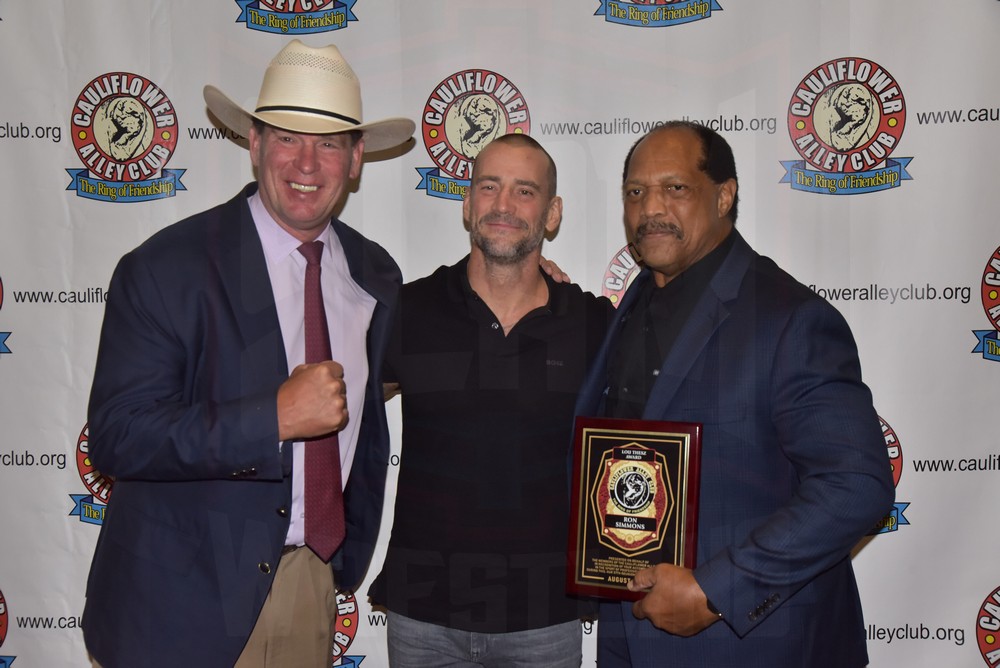
JBL, CM Punk and Ron Simmons at the Cauliflower Alley Club Baloney Blowout on Tuesday, August 29, 2023, at the Plaza Hotel & Casino in Las Vegas. Photo by Scott Romer
Which brings me to Phil ‘CM Punk’ Brooks (doesn’t it always?). To be clear, if Punk and pro wrestling are finished with each other, it’s not for the reasons associated with the likes of Ryan or Elgin or Aries. Punk has long been viewed as a deleterious influence in a locker room, serially unhappy and difficult to deal with. In a business that requires wrestlers to look out for each other, he is not seen as a team player. He even sued his former best friend in the business, then outed said friend’s finances in a post pay-per-view tirade. On multiple occasions, Punk has turned his misery and anger into the lead story on nights where his company should have celebrated its success.
But that’s not what cost him his latest pro wrestling gig.
Punk, who surfaced in AEW in 2021 after an effective seven-year retirement from professional wrestling, was fired ‘for cause’ by AEW on September 2 following a backstage altercation with fellow wrestler Jack Perry at the All In pay per view. Punk is said to have put his hands on Perry and worse — AEW president and CEO Tony Khan. In setting out his reasons for Punk’s termination, Khan indicated that Punk’s actions left him afraid for his life. Punk has yet to comment on the incident, except to drop veiled hints which the internet has taken as a guarantee that he will appear at WWE’s Survivor Series.
It may be too soon to tell whether CM Punk has officially retired from wrestling. At 44 years old he’s still younger than Edge when he attempted his comeback to WWE, but assuming his release from AEW isn’t some grand work (gotta throw that in for the smarks), Punk has now burned bridges with the two largest wrestling companies in the US. I’ve taken plenty of space in this very column discussing improbable comebacks and implausible retirements, so Punk may very well turn up again in either AEW or WWE, but at some point both outfits may decide he’s not worth the risk. Smaller promotions like Impact or the NWA (which attract a lot of notice around SlamWrestling.net and other ‘serious fan’ sites) could be options, but considering Punk held out for almost a decade until Tony Khan opened his wallet, it seems difficult to believe that they could afford him, let alone a barnstorming tour of the independents a la Cody Rhodes or Matt Cardona. If, as was widely reported at the time, Punk was allegedly aggrieved by AEW’s failure to arrange transportation from the local airport to All In, I can’t see him being willing to indulge the semi-professional nature of the indy scene, where paying for transportation is often an issue.
Since I started writing this column, I’ve often paired Edge and Punk. I’m a fan of both wrestlers going back to their initial runs. Maybe it’s the fact that we’re all around the same age. Maybe it’s how I relate to their respective characters. I think a lot of it has to do with how, despite the divergent paths their careers have taken, they’ve both hit similar beats at similar points in those careers. Both men have had their share of struggles inside the ring and outside of it.
Edge had his share of early-career scandals. One such incident turned out positively, as it transformed Edge from a fun, wisecracking babyface into the sleazy Rated R Superstar who would become an 11-time world champion. But Edge has since made peace with the other actors in that bit of personal theatre and has built his own family. Watching Edge on SmackDown I feel as though I’ve watched him grow up. Punk’s repeated challenges and frequent lawsuits suggest that he’s still working on that.
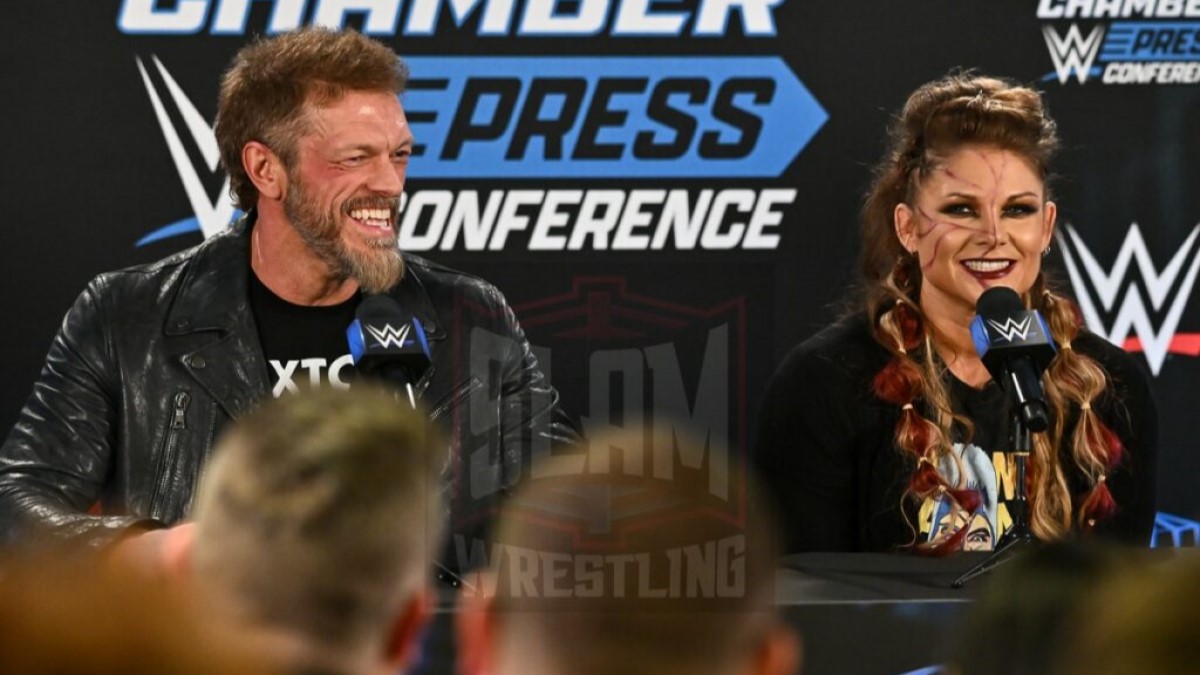
Edge and Beth Phoenix at the post-show press conference after the WWE Elimination Chamber show at Centre Bell in Montreal, Quebec, on Saturday, February 18, 2023. Photo by Minas Panagiotakis, www.photography514.com
As I mentioned a few weeks ago, I think that Edge’s comeback never quite went as it was supposed to, due to an early injury in his rivalry with Randy Orton. While Edge would feature prominently in storylines, I think his torn triceps made WWE scared to promote him more heavily. Maybe he couldn’t live up to his own or their expectations. Punk’s aborted comeback was also hampered by injury and a front office that maximized his exposure without adequately safeguarding his physical or mental health… but his frequent backstage disputes reflected his pride. Punk’s extended layoff and abbreviated AEW run are more likely his own doing, even as Edge seems to lurch between being at peace with his second retirement, and his desire to keep doing what he loves.
I take nothing away from the circumstances under which Punk left WWE. He had been working hurt and was sick, and tired of giving his all to a company which he felt did not appreciate him. Punk was motivated to be a main eventer and frustrated by the fact that he was continually overshadowed by other talent even as he was being asked to do more work. A misdiagnosed infection left him physically and emotionally spent. Heck, WWE infamously fired him on his wedding day. That would leave a bad taste in anyone’s mouth.
I’m not privy to AEW’s backstage environment but on more than one occasion, Punk is alleged to have put his hands on his coworkers and made threatening or intimidating gestures to his boss. At face value, it would seem that AEW had no choice but to fire Punk over his conduct. I’ve noted repeatedly that at AEW’s and WWE’s level pro wrestling is big business, and behind the scenes rules apply that are closer to my desk job than the Wild West.
From a wrestler’s perspective, I can see the dissonance inherent in even a successful career arc. Pro wrestler autobiographies tell a consistent story: from poorly paid, sometimes dangerous shows and exploitive backstage conduct under unscrupulous promoters on the independent scene, wrestlers learn to be careful in the ring and selfish in most aspects of their lives. Personal relationships are readily sacrificed and success is measured in drawing money and convincing/deceiving the public that their actions are ‘real’. From this unregulated, lawless obscurity a few are plucked by the bigger players like WWE or AEW or Impact, with their own varying degrees of professionalism and toxic elements backstage. Disputes that would be resolved physically backstage move to offices, boardrooms and occasionally courtrooms. I’m sure it can be disorienting, but it seems ludicrous that a job based on the simulation of violence for a paid audience can breed actual violence without spectators or drawing a house.
After all of this, I wonder whether Punk has finally decided that he’s had enough with pro wrestling and just wants out, or whether a lifetime of punches and kicks and chair shots and piledrivers, and a semi-successful foray into ‘real’ fighting may have caused legitimate harm. Punk’s unplanned explosions and inappropriate physical confrontations might be manifestations of his unhappiness in general, or they could be violent symptoms of damage to his brain.
For his sake, I hope they’re the former.
TOP PHOTO: Alex Shelley at Impact Wrestling’s Multiverse United 2 on August 20, 2023, at the 2300 Arena, in Philadelphia, Pennsylvania. Photo by George Tahinos, https://georgetahinos.smugmug.com
RELATED LINK
